Abstract
Amine dehydrogenases (AmDHs) efficiently catalyze the NAD(P)H-dependent asymmetric reductive amination of prochiral carbonyl substrates with high enantioselectivity. AmDH-catalyzed oxidative deamination can also be used for the kinetic resolution of racemic amines to obtain enantiopure amines. In the present study, kinetic resolution was carried out using a coupled-enzyme cascade consisting of AmDH and alanine dehydrogenase (AlaDH). AlaDH efficiently catalyzed the conversion of pyruvate to alanine, thus recycling the nicotinamide cofactors and driving the reaction forward. The ee values obtained for the kinetic resolution of 25 and 50 mM rac-α-methylbenzylamine using the purified enzymatic systems were only 54 and 43%, respectively. The use of whole-cells apparently reduced the substrate/product inhibition, and the use of only 30 and 40 mgDCW/mL of whole-cells co-expressing AmDH and AlaDH efficiently resolved 100 mM of rac-2-aminoheptane and rac-α-methylbenzylamine into the corresponding enantiopure (S)-amines. Furthermore, the applicability of the reaction protocol demonstrated herein was also successfully tested for the efficient kinetic resolution of wide range of racemic amines.
1. Introduction
Enantiopure chiral amines are important precursors of numerous small molecule pharmaceuticals, agrochemicals and fine chemicals. It has been estimated that more than one third of the 200 most prescribed small molecule drugs contain chiral amine precursors [1,2,3]. The asymmetric synthesis of amines from prochiral carbonyls and ammonia has also been acknowledged as one of the most highly desired transformations industrially by the ACS Green Chemistry Institute Pharmaceutical Roundtable [4]. The increasing demand for enantiomerically pure compounds and the simultaneous imposition of environmental restrictions by many countries necessitates the effective integration of traditional chemical syntheses with biocatalytic ‘greener’ methods [5,6,7,8,9]. Traditional organo-catalytic methods for the synthesis of chiral amines use toxic intermediates and require environmentally harsh conditions. Moreover, the purification of toxic metals is warranted, which complicates the synthetic methods and its cost [10,11,12].
A surge of interest has occurred in recent years in the use of superior biocatalytic alternatives to the chemical syntheses of chiral amines [13,14]. Enzymes such as transaminases [15], imine reductases [16], amine oxidases [17], P450 monooxygenases [18], lipases [19], and berberine bridge enzyme [20] have been successfully employed for chiral amines synthesis. More recently, amine dehydrogenases (AmDHs)—catalyzing the reductive amination of ketones using ammonia and generating only water as byproduct—have been discovered [21]. Owing to the high enantioselectivity and atom efficiency, AmDH-mediated synthesis is very attractive and a potential biocatalytic approach for the synthesis of chiral amines. However, AmDHs are not ubiquitously present in nature. Nevertheless, Itoh et al. first reported the presence of AmDH in Streptomyces virginiae IFO 12827 [22]. However, this enzyme was unexplored for another decade owing to its poor enantioselectivity and the unavailability of the genetic information. Subsequently, thermostable AmDH from Petrotoga mobiliz DSM 10674 was discovered [23]. Furthermore, the group of Bommarius at Georgia Institute of Technology, U.S.A. generated the first engineered AmDH using Leucine dehydrogenase (LeuDH) from Bacillus stearothermophilus [21]. Bommarius’ group developed second AmDH based on phenylalanine dehydrogenase (PheDH) from Bacillus badius as a scaffold [24]. Furthermore, the Bommarius group generated a chimeric AmDH by domain shuffling of LeuDH and PheDH parental scaffolds. This chimeric AmDH substantially improved the substrate scope of the previously generated AmDHs and converted sterically hindered substrates to their corresponding enantiopure (R)-amine products [25]. Using a similar engineering strategy to that used previously, more AmDHs were generated from L-amino acid dehydrogenase scaffolds from Rhodococcus sp. M4, Exiguobacterium sibiricum, Caldalkalibacillus thermarum and Lysinibacillus fusiformis [26,27,28,29]. These engineered AmDHs have been successfully employed in tandem with other enzymes to obtain various enantiopure compounds. For instance, AmDHs in combination with alcohol dehydrogenases have been used in a redox-neutral two-enzyme cascade for the asymmetric transformation of racemic secondary alcohols into chiral amines [27,30].
AmDH-catalyzed reductive amination of ketones has been widely used for the synthesis of chiral amines. Until very recently, when Mayol et al. [31] characterized six naturally occurring AmDHs which exhibited (S)-selectivity, all the previously generated AmDHs showed exclusive (R)-selectivity owing to their generation from (L)-amino acid dehydrogenase parents. The scarce availability of (S)-selective AmDHs for the generation of (S)-amines can be overcome by (R)-AmDH-mediated kinetic resolution of racemic amines using oxidative deamination. Nevertheless, AmDH-catalyzed oxidative deamination is also an interesting approach that can be used for the kinetic resolution of racemic amines to obtain enantiopure (S)-amines. We have previously reported the specific deamination of the R-amines from racemic mixtures leaving behind the unreacted enantiopure S-amines using a whole-cell biocatalyst expressing AmDH and NADH-oxidase [32]. However, one of the major problems related with this system was the requirement of very high quantities of a whole-cell biocatalyst. For example, the minimum amount of whole-cells required to resolve only 20 mM racemic methylbenzylamine (rac-MBA) into enantiopure (S)-amine was 100 mgDCW/mL. Also, the different optimum pH of AmDH and NADH-oxidase poses a hurdle for the efficient coupled-enzyme reaction.
We envisaged the development of an improved method for the oxidative deamination of racemic amines for the synthesis of their enantiopure (S)-amine counterparts. We herein report a two-enzyme cascade employing AmDH and alanine dehydrogenase (AlaDH) for the kinetic resolution of racemic amines (Figure 1). The specificity of enantioselective AmDHs was exploited for resolving a racemic mixture to obtain only the enantiopure (S)-amines. The major advantage with the use of AlaDH is that it efficiently converts pyruvate to alanine at the expense of NADH, thereby regenerating nicotinamide cofactors, and ultimately, shifting the equilibrium of the primary reaction toward product formation.
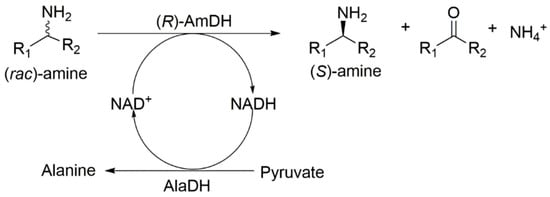
Figure 1.
The oxidative deamination of racemic amines to enantiopure (S)-amines using a two-enzyme cascade employing amine dehydrogenase and alanine dehydrogenase. (R)-AmDH catalyze the oxidative deamination of (R)-amine to corresponding ketone, leaving behind enantiopure (S)-amine. Nicotinamide cofactors were recycled using alanine dehydrogenase.
2. Results and Discussion
2.1. Reactivity of Amine Dehydrogenases toward Racemic Amines
To catalyze the oxidative deamination of racemic amines, two AmDHs, (1) A chimeric AmDH (Chi-AmDH) generated by the domain shuffling of the LeuDH and PheDH [25] and (2) Rs-AmDH (developed from L-phenylalanine dehydrogenase of Rhodococcus sp.) [26] were used in this study. The genes encoding these AmDHs were cloned in pET-24ma vector and transformed in E. coli BL21 (DE3). Following the induction of transformants by IPTG, the His-tagged proteins were purified as previously reported [33].
In order to explore the applicability of AmDHs for the kinetic resolution, the oxidative deamination potential of AmDHs was evaluated toward various racemic amines (Figure 2A). Chi-AmDH and Rs-AmDH displayed varying activity toward racemic amine substrates. While the highest activity by Rs-AmDH was displayed toward 4-phenyl-butan-2-amine (a5), Chi-AmDH showed the highest activity heptan-2-amine (a3). Both enzymes also displayed good activity toward 1-(4-fluorophenyl)propan-2-amine (a6) and 1-m-tolylethanamine (a10) (Figure 2B). The successful oxidative deamination catalyzed by AmDHs suggested their potential for the kinetic resolution of chiral amines to obtain enantiopure (S)-amines.
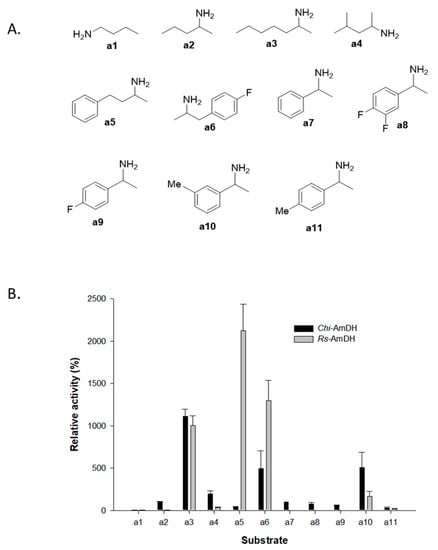
Figure 2.
(A) Racemic amine substrates tested for the kinetic resolution by AmDH-AlaDH system; and (B) The oxidative deamination potential of AmDHs toward various racemic amines; Reaction conditions for oxidative deamination: 10 mM racemic amine substrate, 1 mM NAD+, 0.2 mg/mL AmDHs, 100 mM Glycine buffer (pH 10.0). 27 mU /mg activity was considered as 100%.
2.2. Kinetic Resolution of Racemic Amines Using a Purified AmDH/AlaDH Coupling System
In a two-enzyme cascade reported herein for the kinetic resolution, the oxidative deamination of the R-amines from racemic mixtures to their corresponding ketones, leaving behind the enantiopure (S)-amines, was catalyzed by (R)-AmDHs. The overall efficiency of the reaction largely depends on the availability of nicotinamide cofactors and proficient recycling thereof. Moreover, the efficient recycling of cofactors is necessary to overcome the product inhibition of the primary biocatalyst by the cofactor and to shift the reaction equilibrium toward product formation. Herein, we used alanine dehydrogenase for the regeneration of nicotinamide cofactors. To study the kinetic resolution of racemic amines, rac-α-MBA (rac-a7) and rac-2-aminoheptane (rac-a3) were selected as representative aromatic and aliphatic amines, respectively.
Since the stability and activity of the biocatalysts are dependent on the pH, they can critically affect the overall outcome of the biocatalytic reaction. Especially for reactions catalyzed by the enzymatic cascades, wherein each constituent enzyme exhibits different optimum pH, the pH of the reaction should be carefully determined so that activity of the enzymes is not severely compromised [10,32,33]. Thus, the effect of varying pH on the activities of AmDHs and AlaDH was evaluated (Figure 3). In the case of AlaDH, marginal improvement in activity was observed with the increase in pH of Tris buffer (100 mM) from pH 7.0 to 9.0. The optimum activity of AlaDH was observed at pH 10.0 (Glycine buffer, 100 mM). For AmDHs, steep increase in activity was observed with the increase in pH beyond 9.0. The maximum activity for Chi-AmDH and Rs-AmDH was observed at pH 10.5 and 9.5, respectively. Thus, the kinetic resolution using Chi-AmDH-AlaDH and Rs-AmDH-AlaDH was carried at pH 10.0 and 9.5, respectively.
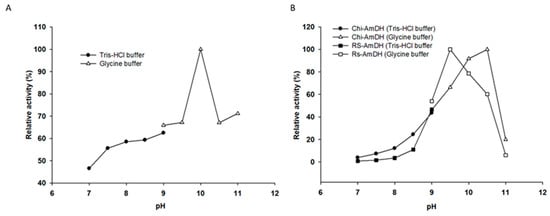
Figure 3.
Effect of pH on the activity of (A) AlaDH; (B) Chi-AmDH; and Rs-AmDH. Reactions conditions: For AmDH assay: 10 mM rac-a7 (rac-a3-for Rs-AmDH), 1 mM NAD+, 0.2 mg/mL AmDH, 100 mM Tris/HCl buffer (pH 7.0–9.0), 100 mM Glycine buffer (pH 9.0–11.0); For AlaDH assay: 10 mM pyruvate, 1 mM NADH, 0.2 mg/mL AlaDH, 100 mM Tris/HCl (pH 7.0–9.0), 100 mM Glycine buffer (pH 9.0–11.0).
Since AlaDH-catalyzed conversion of pyruvate to alanine helps to drive forward the primary reaction of oxidative deamination, it was necessary to determine the optimal concentration of pyruvate needed to catalyze the efficient kinetic resolution of racemic amines. To evaluate the effect of pyruvate, the kinetic resolution of 10 mM rac-2-aminoheptane (rac-a3) and rac-α-MBA (rac-a7) was carried out in 100 mM Glycine buffer (pH 9.5/10.0) containing 1 mM NAD+ with AmDHs (1 mg/mL) and AlaDH (1 mg/mL) with varying concentration of pyruvate. It was observed that increasing concentration of pyruvate improved the enantiomeric excess (ee) of remained (S)-a3 and (S)-a7. The ee values obtained for (S)-a3 and (S)-a7 with the use of 5 mM pyruvate (2:1 of racemic substrate: pyruvate) were 58 and 41%, respectively. The increase in concentration of pyruvate beyond 20 mM (1:2 of racemic substrate: pyruvate) sufficed to obtain the enantiopure (S)-a3 and (S)-a7 with excellent ee values, i.e., >99% (Figure 4).
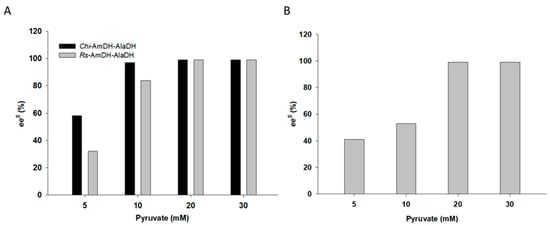
Figure 4.
Effect of pyruvate concentration on the kinetic resolution of (A) rac-a3 by Chi-AmDH-AlaDH and Rs-AmDH-AlaDH; and (B) rac-a7 by Chi-AmDH--AlaDH. Reaction conditions: 10 mM rac-a7/rac-a3, 1 mM NAD+, 1 mg/mL AmDH, 1 mg/mL AlaDH, 5–30 mM Pyruvate, 100 mM Glycine buffer (pH 10.0/9.5).
The successful resolution of 10 mM of rac-a3 and rac-a7 encouraged us to test the applicability of the present coupled enzymatic system for the resolution of higher concentration of racemic amines. Thus, the kinetic resolution of 25 and 50 mM rac-a3 and rac-a7 was carried out in 100 mM Glycine buffer (pH 9.5/10.0) containing 1 mM NAD+ with AmDHs (1 mg/mL) and AlaDH (1 mg/mL) (Figure 5A). The results of this study showed that 25 and 50 mM rac-a3 could be successfully resolved into enantiopure (S)-a3 by both the combinations, i.e., Chi-AmDH-AlaDH and Rs-AmDH-AlaDH. As rac-a7 is not recognized as a substrate by Rs-AmDH, the resolution of 25 and 50 mM rac-a7 was studied using Chi-AmDH-AlaDH system. The reaction profile of the kinetic resolution of rac-a7 showed that the ee values obtained for 25 and 50 mM rac-a7 were 44 and 30%, respectively at 12 h (Figure 5B). The ee values marginally improved with the reaction time and reached up-to 54 and 43% after 24 h with 25 and 50 mM rac-a7, respectively.
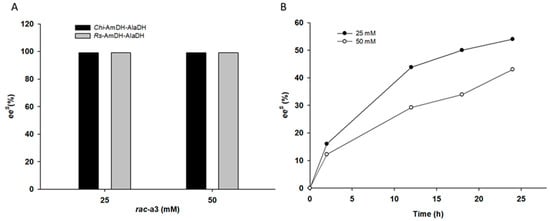
Figure 5.
(A) Kinetic resolution of increased concentration of rac-a3 and (B) Time profile of the kinetic resolution of rac-a7 (25 and 50 mM) using AmDH-AlaDH purified enzyme system. Reaction conditions: 25/50 mM rac-a7 (or rac-a3), 1 mM NAD+, 1 mg/mL AmDH, 1 mg/mL AlaDH, 50/100 mM Pyruvate, 100 mM Glycine buffer (pH 9.5/10.0), 37 °C, 200 rpm for 24 h.
The unsuccessful resolution of higher concentration of rac-a7 implied that the enzymatic reactions demonstrated herein could suffer from substrate/product inhibition. It has also been reported that product inhibition can limit the applicability of the enzymes even with the use of favorable substrates [28]. For instance, native L-amino acid products have been reported to impose severe product inhibition upon various amino acid dehydrogenases [34,35]. Nevertheless, strategies such as biphasic reaction system has been successfully used to overcome the product inhibition in AmDH-catalyzed asymmetric synthesis of amines [36].
Our previous studies for the kinetic resolution of racemic amines using Chi-AmDH-NADH oxidase system also reported the strong inhibition of the enzymes by racemic amine substrates and/or corresponding ketones [32]. We herein studied the product inhibition of Rs-AmDH in the presence of varying concentration of 2-heptanone ranging from 2–30 mM (Figure 6A). As alanine is also produced in the AmDH-AlaDH catalyzed reactions, the effect of varying concentration of alanine (10–100 mM) on the activity of Rs-AmDH was evaluated (Figure 6B). Rs-AmDH retained 61 and 65% of its original activity in the presence of 15 mM 2-heptanone and 50 mM alanine, respectively.
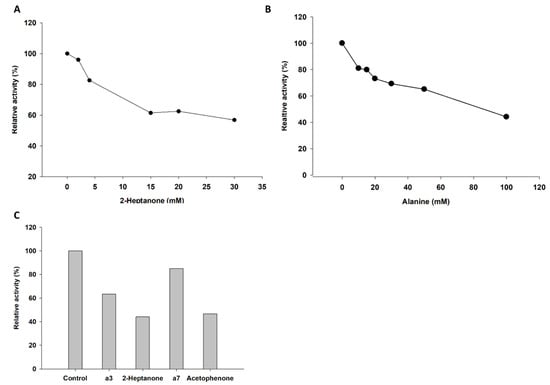
Figure 6.
Inhibition of Rs-AmDH by (A) 2-heptanone; Reaction conditions- 10 mM rac-a3, 0–30 mM 2-heptanone, 1 mM NAD+, 0.2 mg/mL Rs-AmDHs, Buffer- Glycine buffer (100 mM, pH 9.5); (B) Alanine; Reaction conditions- 10 mM rac-a3, 0–100 mM alanine, 1 mM NAD+, 0.2 mg/mL Rs-AmDHs, 100 mM Glycine buffer (pH 9.5) and (C) Inhibition of AlaDH by amines rac-a3 and rac-a7; and ketones 2-heptanone and acetophenone (10 mM each), Control-activity of AlaDH in the absence of amines and ketones.
Also, the inhibition of another constituent enzyme of the coupled enzyme reaction, i.e., alanine dehydrogenase by substrate and product was examined (Figure 6C). The effect of 10 mM racemic amine substrates (rac-a3 and rac-a7), the corresponding ketones (2-heptanone and acetophenone) was studied on the activity of AlaDH. The loss of AlaDH activity in presence of ketones 2-heptanone and acetophenone was higher than that in the presence of amines rac-a3 and rac-a7. The relative activity of AlaDH was 63 and 84% in the presence of 10 mM rac-a3 and rac-a7, respectively. On the other hand, the relative activities of AlaDH in the presence of 10 mM 2-heptanone and acetophenone were only 44 and 46%, respectively.
2.3. Kinetic Resolution of Racemic Amines Using E. coli Whole Cells Co-Expressing AmDH and AlaDH
As enzymes are intracellularly produced, keeping them in their natural environment creates apparent advantages for biocatalytic reactions [37]. The mechanical disruption of microbial cells and subsequent downstream processing for the purification of desired protein in a homogeneous form is very laborious and costly [38,39,40,41,42]. It has been reported that use of purified enzyme system for biocatalytic purposes costs approximately ten times more than that by whole-cell biotransformations [43,44]. Although the use of purified enzymes is limited for their application on large scales, another form of biocatalysts, i.e., cell-free extracts, is feasible if expression levels of the target protein are sufficient [45,46]. However, cell free extracts are unstable. Thus, whole cells expressing the enzyme of interest for the biosynthetic applications are advantageous [47]. Besides the cost effective and simpler handling of whole-cell biotransformations, an added advantage includes the utility of the enzyme production machinery of the fully functional living organism [48,49]. Also, the implementation of biocatalytic syntheses using whole-cell biotransformations is advantageous regarding the regeneration of the redox cofactors [50]. Moreover, whole-cell biocatalysts show less susceptibility to substrate and/or product inhibition due to the diffusional barrier of the cell membrane [51].
The industrial applicability of the biocatalytic processes can be greatly improved with the use of immobilized enzyme systems owing to the improved operational stability and recyclability of the enzymes [52,53]. Moreover, recent years have seen the development of systems comprising of coimmobilized enzymes and cofactors to increase the operational life-span, thereby increasing the cost effectiveness of the processes [54,55]. For example, the group of Lopez-Gallego developed a novel system for the co-immobilization of enzymes and the requisite phosphorylated cofactors on various porous matrices to obtain a self-sufficient heterogenous enzymatic system which is independent of the exogenous addition of the cofactors [55].
The unsuccessful resolution of rac-a7 using the purified enzyme system implied that the coupled-enzyme reactions could suffer from the substrate/product inhibition. Therefore, to catalyze the efficient kinetic resolution of racemic amines, recombinant E. coli cells expressing AmDHs and AlaDH were used as whole-cell biocatalysts. Whole cell biotransformation systems constituting two or more cells, each expressing different protein, may impose the mass transfer limitations [56,57]. In order to develop a single-cell system expressing AmDH and AlaDH, the genes encoding Chi-AmDH-AlaDH and AlaDH were cloned into pET-24ma and pET-Duet vectors, respectively [Since the substrate scope of Chi-AmDH-AlaDH is much better than Rs-AmDH, we only used Chi-AmDH-AlaDH whole cell system]. The plasmids were co-transformed into E. coli cells to generate Chi-AmDH-AlaDH system. Following the induction of transformants by IPTG, cells were grown overnight at 20 °C. The cells were centrifuged (4000× g, 20 min) and washed twice with 50 mM Tris/HCl buffer (pH 7.0). Chi-AmDH-AlaDH cells were resuspended in 100 mM Glycine buffer pH 10.0 and used for whole-cell biotransformations.
To commence the whole-cell biotransformations, kinetic resolutions of 10 mM rac-a3 and rac-a7 were carried out using 10 mgDCW/mL cells. Since cofactor regeneration is efficient in whole cells, these biotransformations were carried out without any external addition of NAD+. Both the racemic substrates were efficiently resolved into corresponding (S)-amines with excellent ee of >99% [Data not shown]. Since our previous studies reported that the kinetic resolution of rac-a7 is more challenging [32], we attempted the kinetic resolution of higher concentrations (20,30 and 50 mM) of rac-a7. The results of these whole-cell biotransformations revealed that the rac-a7, even at the higher concentrations, can be resolved into enantiopure (S)-a7. While the ee values for the resolution of 25 and 50 mM rac-a7 using the purified enzymatic system were 54 and 43%, respectively at 24 h (Figure 5B), ee values obtained using 30 mgDCW/mL whole cells of Chi-AmDH-AlaDH were >99% after 12 h for the resolution of 20, 30 and 50 mM rac-a7, implying that whole-cell biotransformations were highly efficient than purified enzymatic systems (Figure 7). Also, the whole cell biotransformation could efficiently resolve 50 mM rac-a3 with excellent ee values (>99%; data not shown). These results were in a good agreement with previous studies by Pushpanath et al. [28], who reported that the lyophilized whole-cells yielded better conversion values than those by lyophilized lysate for the asymmetric synthesis of amines from prochiral ketones.
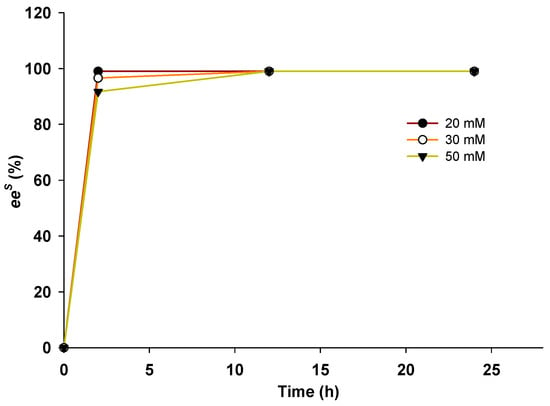
Figure 7.
Reaction profiles for the kinetic resolution of 20, 30 and 50 mM rac-a7 using Chi-AmDH-AlaDH whole cell system; Reaction conditions: (20/30 or 50 mM rac-a7, 40/60 or 100 mM pyruvate), 100 mM glycine buffer pH 10.0, 30 mgDCW/mL Chi-AmDH-AlaDH cells, 37 °C, 200 rpm for 24 h).
The successful resolution of 50 mM rac-a3 and rac-a7 encouraged us to further evaluate the efficiency of this reaction cascade for the resolution of higher concentration of racemic amines. Thus, to determine the optimal amount of whole cell biocatalyst required to obtain enantiopure (S)-amines from 100 mM rac-a3 and rac-a7 substrates, reactions were carried out using varying concentration of whole cell catalyst ranging from 10–60 mgDCW/mL (Figure 8). The ee of (S)-amines increased with the increasing amount of Chi-AmDH-AlaDH whole-cell catalyst. While 30 mgDCW/mL cells sufficed to completely resolve 100 mM rac-a3 into enantiopure (S)-a3, the minimum number of cells required to resolve 100 mM rac-a7 were 40 mgDCW/mL. These results corroborated the results of the previous studies which exhibited the higher inhibition of Chi-AmDH by acetophenone than that by 2-heptanone [32]. The higher efficiency of the coupled Chi-AmDH-AlaDH system demonstrated herein is worth emphasizing, given that the minimum number of previously reported Chi-AmDH-NOX cells required to completely resolve only 50 mM rac-a3 and rac-a7 were 60 and 100 mg DCW/mL [32]. On the other hand, only 30 and 40 mg DCW/mL Chi-AmDH-AlaDH cells sufficed to completely resolve 100 mM of rac-a3 and rac-a7, respectively (Figure 8).
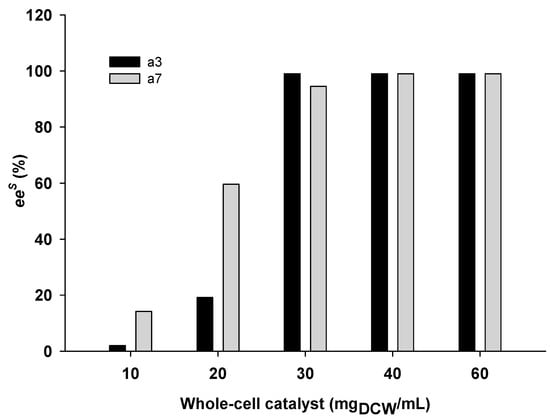
Figure 8.
Effect of concentration of whole-cell catalyst on the kinetic resolution of 100 mM rac-a3 and rac-a7. Reaction conditions: (100 mM rac-a3 or rac-a7, 200 mM Pyruvate), 100 mM glycine buffer pH 10.0, 10–60 mgDCW/mL Chi-AmDH-AlaDH cells, 37 °C, 200 rpm for 24 h).
In order to investigate the applicability of the coupled-enzyme system designed herein, the kinetic resolution of various racemic amine substrates to their corresponding enantiopure (S)-amines was performed [Table 1]. All the racemic substrates, except a1 and a2, were successfully resolved into their corresponding (S)-amine form with excellent ee of >99% (Figures S3–S11). The kinetic resolution of a1 and a2 resulted in ee values of 19 and 59%, respectively. Although substrate specificity suggested the varying activity of AmDH toward various racemic amine substrates, a clear correlation between conversion and the reactivity of substrates could not be demonstrated. Nevertheless, it can be stated that AlaDH-catalyzed conversion of pyruvate to alanine efficiently shifted the equilibrium of the oxidative deamination in such a fashion that the kinetic resolution of racemic substrates was catalyzed independent of their activity toward AmDH.

Table 1.
Kinetic resolution of various racemic amines.
3. Materials and Methods
3.1. Chemicals and Media
All the racemic amine substrates (rac-a1–a11), derivatizing agent 2,3,4,6-Tetra-O-acetyl-β-d-glucopyranosyl isothiocynate (GITC), nicotinamide cofactors (NADH and NAD+) were purchased from Sigma-Aldrich (Yongin, Korea). All the other chemical and reagents used were of analytical grade.
3.2. Enzyme Expression and Purification
The gene encoding Chi-AmDH [25] and Rs-AmDH [26] was synthesized by Bionics (Seoul, Korea). The genes were cloned into IPTG-inducible pET-24ma vector, expressed and purified as previously reported [33,51].
3.3. Co-Expression of Chi-AmDH and AlaDH
The gene encoding AmDH was cloned into pET24ma vector and AlaDH in pET-duet vector. Both the plasmids were transformed by heat shock method to E. coli BL21 cells. The cells were grown in the presence of Ampicillin (100 µg/mL) and kanamycin (50 µg/mL). Once OD600 of the cells reached 0.6–0.8, IPTG was added (0.1 mM final concentration) and cells were cultivated overnight. The cells were centrifuged and washed with tris buffer (20 mM, pH 7.0). Cells were centrifuged again, resuspended in Glycine buffer (100 mM, pH 10.0) and used for whole-cell transformations.
3.4. Representative Procedure for Whole-Cell Biotransformations for the Kinetic Resolution of Racemic Amines
E. coli cells co-transformed with plasmids pET-24ma and pET-duet harboring Chi-AmDH and AlaDH, respectively were cultivated overnight following their induction by IPTG. The induced cells were centrifuged (4000× g, 20 min, 4 °C). The cell pellet was washed twice with tris buffer (20 mM, pH 7.0) and recollected by centrifugation. The washed were resuspended in Glycine buffer (100 mM, pH 10.0) and used for whole-cell biotransformations. To assess the kinetic resolution of racemic amine substrates, reaction was carried out containing 10 mM substrate (rac-a1–a11; stock in DMSO), 20 mM pyruvate, 30 mgDCW/mL E. coli cells co-expressing Chi-AmDH and AlaDH and Glycine buffer (100 mM, pH 10.0) in a final volume of 1 mL in 1.5 mL microcentrifuge tubes. This reaction mixture was incubated at 37 ◦C and 200 rpm for 24 h. Biotransformation were initiated. After 24 h, the reaction mixture was centrifuged (10,000× g, 20 min) to remove the cellmass and the supernatant was quantified by HPLC for the remaining (S)-amines.
3.5. Analysis of Amines
The analysis of kinetic resolution of racemic amines to their enantiopure (S)-amines was performed as previously reported [32,33].
4. Conclusions
Since their generation by protein engineering strategies from L-amino acid dehydrogenase parent scaffolds, amine dehydrogenases have been used for the reductive amination of prochiral ketone to chiral amines. Nevertheless, (R)-AmDH-catalyzed oxidative deamination can also be efficiently used for the kinetic resolution of racemic amines to enantiopure (S)-amines. Kinetic resolution was performed using a coupled-enzyme reaction cascade consisting of AmDH and AlaDH. The use of AlaDH was advantageous not only for cofactor regeneration, but also for the effective conversion of pyruvate to alanine, thereby shifting the reaction equilibrium of the primary reaction toward product formation. Another advantage of this reaction protocol is that the optimum pHs for both the enzymes are close to each other, implying that reactions using coupled-enzyme systems can be efficiently performed without compromising the activities of the constituent enzymes. Although a purified enzyme system could not resolve higher concentrations of challenging racemic substrate such as a7, the whole-cell biotransformations efficiently resolved racemic amines substrates. By using the whole-cell system expressing AmDH and AlaDH, 100 mM each of rac-2-aminoheptane and rac-α-MBA were successfully resolved into (S)-form with >99% ee, respectively. Furthermore, this reaction protocol enabled the kinetic resolution of wide range of chiral amines to their corresponding (S)-amines with excellent enantioselectivity (ee > 99%). One of the major disadvantages with the use of pyruvate is its cost, which ultimately affects the overall cost of the biocatalytic process. Nevertheless, the recent discovery of enantiocomplementary (S)-AmDHs [31] suggests that the applicability of the protocols such as that demonstrated herein could also be efficiently extended to generate enantiopure (R)-amines.
Supplementary Materials
The following are available online at https://www.mdpi.com/2073-4344/9/7/600/s1, Figure S1: SDS-PAGE analysis of purified AmDHs and AlaDH, Figure S2: SDS-PAGE analysis of whole-cells expressing AmDHs and AlaDH, Figures S3–S13: HPLC analyses of kinetic resolution of rac-a1–rac-a11 (red line) to (S)-a1–(S)-a11 (black line), Table S1: Amine retention times.
Author Contributions
H.Y. and M.D.P. designed the experiments of the project; M.D.P., S.Y., T.P.K. and S.S. performed the experiments, H.J., A.D.P. and Y.W. contributed reagents/materials/analysis tools. M.D.P. drafted this manuscript; H.Y. proofread the manuscript and supervised the studies.
Funding
This work was supported by the Ministry of Trade, Industry and Energy of South Korea (MOTIE, Korea) under the Industrial Technology Innovation Program (No. 10062550 and No. 10076343).
Conflicts of Interest
The authors declare no financial or commercial conflict of interest.
References
- Bommarius, A.S. Amine dehydrogenases occur in nature. Nature Catal. 2019, 2, 288. [Google Scholar] [CrossRef]
- Ghislieri, D.; Turner, N.J. Biocatalytic Approaches to the Synthesis of Enantiomerically Pure Chiral Amines. Top. Catal. 2014, 57, 284–300. [Google Scholar] [CrossRef]
- Mathew, S.; Yun, H. ω-Transaminases for the Production of Optically Pure Amines and Unnatural Amino Acids. ACS Catal. 2012, 2, 993–1001. [Google Scholar] [CrossRef]
- Constable, D.J.; Dunn, P.J.; Hayler, J.D.; Humphrey, G.R.; Leazer, J.L., Jr.; Linderman, R.J.; Lorenz, K.; Manley, J.; Pearlman, B.A.; Wells, A.; et al. Key green chemistry research areas—A perspective from pharmaceutical manufacturers. Green Chem. 2007, 9, 411–420. [Google Scholar] [CrossRef]
- Patil, M.D.; Grogan, G.; Yun, H. Biocatalyzed C−C Bond Formation for the Production of Alkaloids. ChemCatChem 2018, 10, 4783–4804. [Google Scholar] [CrossRef]
- Lalonde, J. Highly engineered biocatalysts for efficient small molecule pharmaceutical synthesis. Curr. Opin. Biotechnol. 2016, 42, 152–158. [Google Scholar] [CrossRef] [PubMed]
- Roper, L.; Grogan, G. Biocatalysis for Organic Chemists: Hydroxylations. In Organic Synthesis Using Biocatalysis; Goswami, A., Stewart, J., Eds.; Elsevier: Amsterdam, The Netherlands, 2015; pp. 213–241. [Google Scholar]
- Sun, H.; Zhang, H.; Ang, E.; Zhao, H. Biocatalysis for the Synthesis of Pharmaceuticals and Pharmaceutical Intermediates. Bioorg. Med. Chem. 2018, 26, 1275–1284. [Google Scholar] [CrossRef] [PubMed]
- Truppo, M.D. Biocatalysis in the Pharmaceutical Industry—The Need for Speed. ACS Med. Chem. Lett. 2017, 8, 476–480. [Google Scholar] [CrossRef] [PubMed]
- Hwang, E.T.; Lee, S. Multi-Enzymatic Cascade Reactions via Enzyme Complex by Immobilization. ACS Catal. 2019, 9, 4402–4425. [Google Scholar] [CrossRef]
- Kurti, L. Streamlining Amine Synthesis. Science 2015, 348, 863–864. [Google Scholar] [CrossRef]
- Busto, E.; Simon, R.C.; Richter, N.; Kroutil, W. Enzymatic Synthesis of Chiral Amines using ω -Transaminases, Amine Oxidases, and the Berberine Bridge Enzyme. In Green Biocatalysis, 1st ed.; Patel, R.N., Ed.; John Wiley & Sons, Inc.: Hoboken, NJ, USA, 2016; pp. 17–57. [Google Scholar]
- Kohls, H.; Steffen-Munsberg, F.; Hohne, M. Recent Achievements in Developing the Biocatalytic Toolbox for Chiral Amine Synthesis. Curr. Opin. Chem. Biol. 2014, 19, 180–192. [Google Scholar] [CrossRef] [PubMed]
- Brundiek, H.; Hohne, M. Transaminases—A Biosynthetic Route for Chiral Amines. In Applied Biocatalysis: From Fundamental Science to Industrial Applications; Hilterhaus, L., Liese, A., Kettling, U., Antranikian, G., Eds.; Wiley—VCH Verlag GmbH & Co.: Weinheim, Germany, 2016; pp. 199–218. [Google Scholar]
- Patil, M.D.; Grogan, G.; Bommarius, A.; Yun, H. Recent Advances in ω-Transaminase-Mediated Biocatalysis for the Enantioselective Synthesis of Chiral Amines. Catalysts 2018, 8, 254. [Google Scholar] [CrossRef]
- Sharma, M.; Mangas-Sanchez, J.; Turner, N.J.; Grogan, G. NAD(P)H-Dependent Dehydrogenases for the Asymmetric Reductive Amination of Ketones: Structure, Mechanism, Evolution and Application. Adv. Synth. Catal. 2017, 359, 2011–2025. [Google Scholar] [CrossRef] [PubMed]
- Batista, V.F.; Galman, J.L.; GA Pinto, D.C.; Silva, A.M.; Turner, N.J. Monoamine oxidase: Tunable activity for amine resolution and functionalization. ACS Catal. 2018, 8, 11889–11907. [Google Scholar] [CrossRef]
- Durairaj, P.; Hur, J.S.; Yun, H. Versatile Biocatalysis of Fungal Cytochrome P450 Monooxygenases. Microb. Cell Fact. 2016, 15, 125. [Google Scholar] [CrossRef] [PubMed]
- Sanfilippo, C.; Paternò, A.A.; Patti, A. Resolution of racemic amines via lipase-catalyzed benzoylation: Chemoenzymatic synthesis of the pharmacologically active isomers of labetalol. Mol. Catal. 2018, 449, 79–84. [Google Scholar] [CrossRef]
- Schmidt, N.G.; Eger, E.; Kroutil, W. Building bridges: Biocatalytic C–C-bond formation toward multifunctional products. ACS Catal. 2016, 6, 4286–4311. [Google Scholar] [CrossRef] [PubMed]
- Abrahamson, M.J.; Vázquez-Figueroa, E.; Woodall, N.B.; Moore, J.C.; Bommarius, A.S. Development of an Amine Dehydrogenase for Synthesis of Chiral Amines. Angew. Chem. Int. Ed. 2012, 51, 3969–3972. [Google Scholar] [CrossRef]
- Itoh, N.; Yachi, C.; Kudome, T. Determining a Novel NAD+-Dependent Amine Dehydrogenase with a Broad Substrate Range from Streptomyces virginiae IFO 12827: Purification and Characterization. J. Mol. Catal. B: Enzym. 2000, 10, 281–290. [Google Scholar] [CrossRef]
- Mayol, O.; David, S.; Darii, E.; Debard, A.; Mariage, A.; Pellouin, V.; Petit, J.L.; Salanoubat, M.; de Berardinis, V.; Zaparucha, A.; et al. Asymmetric Reductive Amination by a Wild-Type Amine Dehydrogenase from the Thermophilic Bacteria Petrotoga mobilis. Catal. Sci. Technol. 2016, 6, 7421–7428. [Google Scholar] [CrossRef]
- Abrahamson, M.J.; Wong, J.W.; Bommarius, A.S. The Evolution of an Amine Dehydrogenase Biocatalyst for the Asymmetric Production of Chiral Amines. Adv. Synth. Catal. 2013, 355, 1780–1786. [Google Scholar] [CrossRef]
- Bommarius, B.R.; Schurmann, M.; Bommarius, A.S. A Novel Chimeric Amine Dehydrogenase Shows Altered Substrate Specificity Compared to its Parent Enzymes. Chem. Commun. 2014, 50, 14953–14955. [Google Scholar] [CrossRef] [PubMed]
- Ye, L.J.; Toh, H.H.; Yang, Y.; Adams, J.P.; Snajdrova, R.; Li, Z. Engineering of Amine Dehydrogenase for Asymmetric Reductive Amination of Ketone by Evolving Rhodococcus Phenylalanine Dehydrogenase. ACS Catal. 2015, 5, 1119–1122. [Google Scholar] [CrossRef]
- Chen, F.F.; Liu, Y.Y.; Zheng, G.W.; Xu, J.H. Asymmetric Amination of Secondary Alcohols by using a Redox-Neutral Two- Enzyme Cascade. ChemCatChem 2015, 7, 3838–3841. [Google Scholar] [CrossRef]
- Pushpanath, A.; Siirola, E.; Bornadel, A.; Woodlock, D.; Schell, U. Understanding and Overcoming the Limitations of Bacillus badius and Caldalkalibacillus thermarum Amine Dehydrogenases for Bio-catalytic Reductive Amination. ACS Catal. 2017, 7, 3204–3209. [Google Scholar] [CrossRef]
- Chen, F.F.; Zheng, G.W.; Liu, L.; Li, H.; Chen, Q.; Li, F.L.; Li, C.X.; Xu, J.H. Reshaping the active pocket of amine dehydrogenases for asymmetric synthesis of bulky aliphatic amines. ACS Catal. 2018, 8, 2622–2628. [Google Scholar] [CrossRef]
- Mutti, F.G.; Knaus, T.; Scrutton, N.S.; Breuer, M.; Turner, N.J. Conversion of Alcohols to Enantiopure Amines Through Dual-Enzyme Hydrogen-Borrowing Cascades. Science 2015, 349, 1525–1529. [Google Scholar] [CrossRef]
- Mayol, O.; Bastard, K.; Beloti, L.; Frese, A.; Turkenburg, J.P.; Petit, J.L.; Mariage, A.; Debard, A.; Pellouin, V.; Perret, A.; et al. A family of native amine dehydrogenases for the asymmetric reductive amination of ketones. Nature Catal. 2019, 2, 324–333. [Google Scholar] [CrossRef]
- Jeon, H.; Yoon, S.; Ahsan, M.; Sung, S.; Kim, G.H.; Sundaramoorthy, U.; Rhee, S.K.; Yun, H. The Kinetic resolution of racemic amines using a whole-cell biocatalyst co-expressing amine dehydrogenase and NADH oxidase. Catalysts 2017, 7, 251. [Google Scholar] [CrossRef]
- Yoon, S.; Patil, M.D.; Sarak, S.; Jeon, H.; Kim, G.H.; Khobragade, T.P.; Sung, S.; Yun, H. Deracemization of Racemic Amines to Enantiopure (R)-and (S)-amines by Biocatalytic Cascade Employing ω-Transaminase and Amine Dehydrogenase. ChemCatChem 2019, 11, 1898–1902. [Google Scholar] [CrossRef]
- Li, J.; Pan, J.; Zhang, J.; Xu, J.H. Stereoselective synthesis of L-tert-leucine by a newly cloned leucine dehydrogenase from Exiguobacterium sibiricum. J. Mol. Catal. B: Enzym. 2014, 105, 11–17. [Google Scholar] [CrossRef]
- Brunhuber, N.M.; Thoden, J.B.; Blanchard, J.S.; Vanhooke, J.L. Rhodococcus L-phenylalanine dehydrogenase: Kinetics, mechanism, and structural basis for catalytic specifity. Biochemistry 2000, 39, 9174–9187. [Google Scholar] [CrossRef] [PubMed]
- Au, S.K.; Bommarius, B.R.; Bommarius, A.S. Biphasic reaction system allows for conversion of hydrophobic substrates by amine dehydrogenases. ACS Catal. 2014, 4, 4021–4026. [Google Scholar] [CrossRef]
- Patil, M.D.; Dev, M.J.; Shinde, A.S.; Bhilare, K.D.; Patel, G.; Chisti, Y.; Banerjee, U.C. Surfactant-mediated permeabilization of Pseudomonas putida KT2440 and use of the immobilized permeabilized cells in biotransformation. Process Biochem. 2017, 63, 113–121. [Google Scholar] [CrossRef]
- Patil, M.D.; Shinde, A.S.; Dev, M.J.; Patel, G.; Bhilare, K.D.; Banerjee, U.C. Combined effect of attrition and ultrasound on the disruption of Pseudomonas putida for the efficient release of arginine deiminase. Biotechnol. Progr. 2018, 34, 1185–1194. [Google Scholar] [CrossRef] [PubMed]
- Patil, M.D.; Dev, M.J.; Tangadpalliwar, S.; Patel, G.; Garg, P.; Chisti, Y.; Banerjee, U.C. Ultrasonic disruption of Pseudomonas putida for the release of arginine deiminase: Kinetics and predictive models. Bioresour. Technol. 2017, 233, 74–83. [Google Scholar] [CrossRef] [PubMed]
- Patil, M.D.; Rathod, V.P.; Bihade, U.R.; Banerjee, U.C. Purification and characterization of arginine deiminase from Pseudomonas putida: Structural insights of the differential affinities of L-arginine analogues. J. Biosci. Bioeng. 2019, 127, 129–137. [Google Scholar] [CrossRef]
- Bhilare, K.D.; Patil, M.D.; Tangadpalliwar, S.; Dev, M.J.; Garg, P.; Banerjee, U.C. Machine learning modelling for the high-pressure homogenization-mediated disruption of recombinant E. coli. Process Biochem. 2018, 71, 182–190. [Google Scholar] [CrossRef]
- Patil, M.D.; Patel, G.; Surywanshi, B.; Shaikh, N.; Garg, P.; Chisti, Y.; Banerjee, U.C. Disruption of Pseudomonas putida by high pressure homogenization: A comparison of the predictive capacity of three process models for the efficient release of arginine deiminase. AMB Express 2016, 6, 84. [Google Scholar] [CrossRef]
- Sheldon, R.A.; Brady, D. The limits to biocatalysis: Pushing the envelope. Chem. Commun. 2018, 54, 6088–6104. [Google Scholar] [CrossRef]
- Wachtmeister, J.; Rother, D. Recent advances in whole cell biocatalysis techniques bridging from investigative to industrial scale. Curr. Opin. Biotechnol. 2016, 42, 169–177. [Google Scholar] [CrossRef] [PubMed]
- Kim, G.H.; Jeon, H.; Khobragade, T.P.; Patil, M.D.; Sung, S.; Yoon, S.; Won, Y.; Sarak, S.; Yun, H. Glutamate as an Efficient Amine Donor for the Synthesis of Chiral β-and γ-Amino Acids Using Transaminase. ChemCatChem 2019, 11, 1437–1440. [Google Scholar] [CrossRef]
- Bhilare, K.D.; Patil, M.D.; Tangadpalliwar, S.; Shinde, A.; Garg, P.; Banerjee, U.C. Machine learning modelling for the ultrasonication-mediated disruption of recombinant E. coli for the efficient release of nitrilase. Ultrasonics 2019, 98, 72–81. [Google Scholar] [CrossRef] [PubMed]
- Molnár, Z.; Farkas, E.; Lakó, Á.; Erdélyi, B.; Kroutil, W.; Vértessy, B.G.; Paizs, C.; Poppe, L. Immobilized Whole-Cell Transaminase Biocatalysts for Continuous-Flow Kinetic Resolution of Amines. Catalysts 2019, 9, 438. [Google Scholar] [CrossRef]
- Ahsan, M.M.; Patil, M.D.; Jeon, H.; Sung, S.; Chung, T.; Yun, H. Biosynthesis of Nylon 12 Monomer, ω-Aminododecanoic Acid Using Artificial Self-Sufficient P450, AlkJ and ω-TA. Catalysts 2018, 8, 400. [Google Scholar] [CrossRef]
- Ahsan, M.M.; Jeon, H.P.; Nadarajan, S.P.; Chung, T.; Yoo, H.W.; Kim, B.G.; Patil, M.D.; Yun, H. Biosynthesis of the nylon 12 monomer, ω-Aminododecanoic acid with novel CYP153A, AlkJ, and ω-TA enzymes. Biotechnol. J. 2018, 13, 1700562. [Google Scholar] [CrossRef] [PubMed]
- Patil, M.D.; Grogan, G.; Bommarius, A.; Yun, H. Oxidoreductase-catalyzed synthesis of chiral amines. ACS Catal. 2018, 8, 10985–11015. [Google Scholar] [CrossRef]
- Kim, G.H.; Jeon, H.; Khobragade, T.P.; Patil, M.D.; Sung, S.; Yoon, S.; Won, Y.; Choi, I.S.; Yun, H. Enzymatic synthesis of sitagliptin intermediate using a novel ω-transaminase. Enzyme Microb. Technol. 2019, 120, 52–60. [Google Scholar] [CrossRef]
- Schmid-Dannert, C.; López-Gallego, F. Advances and opportunities for the design of self-sufficient and spatially organized cell-free biocatalytic systems. Curr. Opin. Chem. Biol. 2019, 49, 97–104. [Google Scholar] [CrossRef]
- Velasco-Lozano, S.; López-Gallego, F. Wiring step-wise reactions with immobilized multi-enzyme systems. Biocatal. Biotransform. 2018, 36, 184–194. [Google Scholar] [CrossRef]
- Beniítez-Mateos, A.I.; Contente, M.L.; Velasco-Lozano, S.; Paradisi, F.; López-Gallego, F. Self-sufficient flow-biocatalysis by coimmobilization of pyridoxal 5′-phosphate and ω-transaminases onto porous carriers. ACS Sustain. Chem. Eng. 2018, 6, 13151–13159. [Google Scholar] [CrossRef]
- Velasco-Lozano, S.; Benítez-Mateos, A.I.; López-Gallego, F. Co-immobilized Phosphorylated Cofactors and Enzymes as Self-Sufficient Heterogeneous Biocatalysts for Chemical Processes. Angew. Chem. Int. Ed. 2017, 56, 771–775. [Google Scholar] [CrossRef] [PubMed]
- Sung, S.; Jeon, H.; Sarak, S.; Ahsan, M.M.; Patil, M.D.; Kroutil, W.; Kim, B.G.; Yun, H. Parallel anti-sense two-step cascade for alcohol amination leading to ω-amino fatty acids and α, ω-diamines. Green Chem. 2018, 20, 4591–4595. [Google Scholar] [CrossRef]
- Ahsan, M.; Sung, S.; Jeon, H.; Patil, M.; Chung, T.; Yun, H. Biosynthesis of medium-to long-chain α, ω-diols from free fatty acids using CYP153A monooxygenase, carboxylic acid reductase, and E. coli endogenous aldehyde reductases. Catalysts 2017, 8, 4. [Google Scholar] [CrossRef]
© 2019 by the authors. Licensee MDPI, Basel, Switzerland. This article is an open access article distributed under the terms and conditions of the Creative Commons Attribution (CC BY) license (http://creativecommons.org/licenses/by/4.0/).